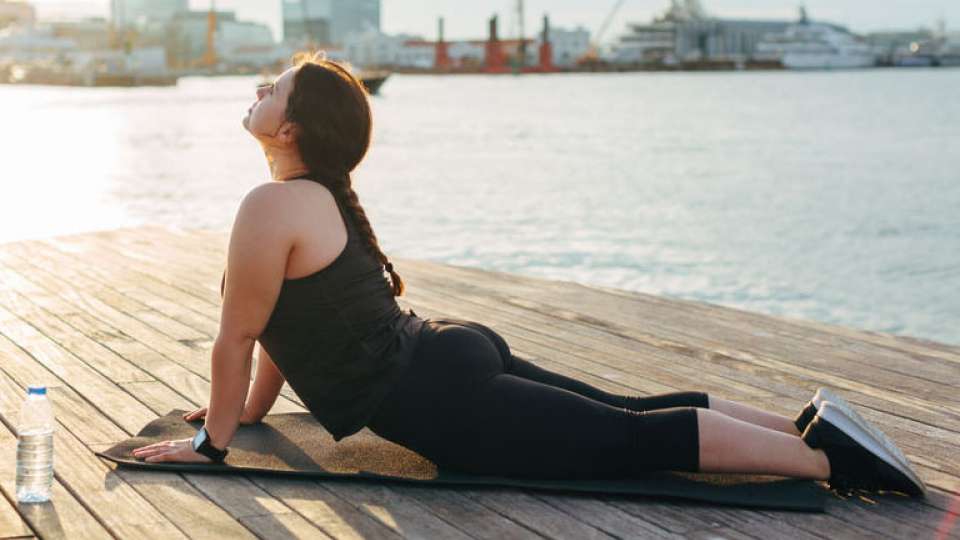Keep It Cool This Summer With These 6 Hot Weather Exercise Tips

The sun may not show its face that often in the Pacific Northwest, but during the months when it does, you better believe Seattleites will be outside enjoying its company. Whether you’re taking a loop around Green Lake or Lake Union, or venturing out to the coast or into the mountains, the options for outdoor exercise are seemingly endless.
But working out on hot, sunny days can leave you exposed to risks like dehydration and heatstroke, says Christopher McMullen, M.D., sports medicine fellow for the University of Washington’s Department of Rehabilitation Medicine.
“In general, I’d say that the benefits of exercise, no matter the conditions, seem to outweigh the risk,” he says.
In other words, don’t let the heat stop you from exercising, but take care of yourself out there. These tips will keep you moving safely even during the hottest mid-summer days.
Hydrate, hydrate, hydrate
Staying hydrated is important any time, but especially when it’s hot out and you’re losing more fluid through sweat, says McMullen. The American College of Sports Medicine (ACSM) recommends drinking 16 to 20 ounces of water in the four hours before exercise.
Make sure you have access to not just water when you’re working out in the heat, but electrolyte-containing drinks or supplements too, especially if you’re doing any sort of endurance activity.
“When you’re exercising, a good rule is to drink when you’re thirsty,” says McMullen. “Your body is pretty good at regulating how much fluid you need.”
Overhydration is rare, but possible. The ACSM recommends limiting water consumption to no more than 27 ounces per hour to avoid electrolyte depletion.
Dress the part
Save your favorite cotton T-shirt for a cooler day. Research shows that wearing a fitted polyester shirt designed to be moisture-wicking is better for staying cool when exercising in hot temps.
“Synthetic fibers are typically better because they wick away moisture and dry easier, allowing you to cool off,” says McMullen.
Those black leggings might not be your best bet, either. Light-colored clothing reflects the sun’s rays and generally keeps you cooler than darker colors, he says.
If you’re heading into the mountains, wear clothing that will protect you from the sun, but also keeps you ventilated, says Gina Peterson, D.P.T., a physical therapist at Advanced Manual Therapy & Sports Rehabilitation at Northwest Outpatient Medical Center.
Opt for a backpack that has foam and mesh panels on the back—or ditch the backpack altogether and wear a fanny pack. Either of these choices will help regulate your core body temperature by allowing air to flow to your back. Denser backpacks, on the other hand, trap heat and can make you overheat faster.
Eat before exercise
Exercising in the heat can take a lot out of you, so it’s important to go into it feeling your best.
“Make sure you consume balanced nutrition early in the day and that you’re not in a place where you’re feeling depleted already,” says Peterson.
That means you can have that salad for lunch, but be sure to add toppings with fat and protein if you plan on exercising late in the day so you have the energy you need. If you’re feeling hungry before you exercise, have a 200- to 300-calorie carbohydrate-dense snack that’s easy to digest, like fruit, whole grains, potatoes or yams.
Exercise early or late in the day
This one requires some planning ahead, but if you can, McMullen recommends adjusting your schedule so you aren’t exercising when the sun is directly overhead.
Luckily, with the sun rising before 6 a.m. and setting after 9 p.m., there’s lots of time in the day to exercise outdoors without being in the midday heat.
Avoid concrete and pavement when you can
These surfaces retain more heat than grassy areas, water or trails. Add the heat from the sun to the heat coming from below and it becomes extra important to pay attention to your hydration status and how your body is feeling during exercise, says Peterson.
“If you can, try and seek out other surfaces. Being by a body of water has a regulating effect. Trails offer intermittent shade and the ground also tends to be cooler, so the temperature right above the ground is not as high,” she says.
Listen to your body
Exercise is essential to good health and is something you should do all year, but there are some signs, like a dry mouth or headache, that signal it’s time to take a rest, says Peterson. Listening to your body is important; if you exercise regularly, chances are you know what your body usually feels like after a 2-mile jog, or whatever your exercise of choice.
“If you feel different than you usually do because of the heat, that’s a good time to take a rest, evaluate your hydration and decide whether it’s a good idea to keep going,” she says. “Body awareness is important.”
Whether your idea of active summer fun is a stroll outside with a friend or trekking up a mountain, paying attention to your body’s cues and following some simple safety tips can keep you feeling cool and safe. And don’t forget your sunscreen!

 Healthy ideas for your inbox
Healthy ideas for your inbox





